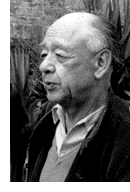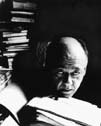|

|
|

|
.
|
Culture, history,
language, travel,
and more!
|
|
|
EUGENE IONESCO - French Dramatist
|

The Romanian-born
Eugène Ionesco {ee-oh-nes'-koh, u-zhen'}, b. Nov. 26, 1912, d.
Mar. 28, 1994, was one of the foremost playwrights of the theater of
the absurd. The son of a Romanian father and a French mother, he
spent most of his childhood in France but in his early teenage years
returned to Romania, where he qualified as a teacher of French and
married in 1936.  He
returned to France in 1938 to complete his doctoral thesis. Caught by
the outbreak of war in 1939, he settled there, earning his living as
a proofreader for publishers.
He
returned to France in 1938 to complete his doctoral thesis. Caught by
the outbreak of war in 1939, he settled there, earning his living as
a proofreader for publishers.
Ionesco came to
playwriting almost by chance. Having decided to learn English, he was
struck by the emptiness of the cliches of daily conversation that
appeared in his phrase book. Out of such nonsensical sentences he
constructed his first play, The Bald Soprano (1950; Eng.
trans., 1958), which satirizes the deadliness and idiocy of the daily
life of a bourgeois society frozen in meaningless formalities.
Greatly surprised by the success of the play, Ionesco embarked on a
career as a writer of what he called antiplays, which
characteristically combine a dream or nightmare atmosphere with
grotesque, bizarre, and whimsical humor. In his work the tragic and
farcical are fused.
In The Lesson
(1951; Eng. trans., 1958), a teacher gains domination over his pupil
through his superior use of language and finally kills her. In The
Chairs (1952; Eng. trans., 1958), an old couple attempt to pass
on their total life experience to humanity by inviting to a gathering
a vast crowd of guests who never arrive but whose nonpresence is
symbolized by a proliferation of empty chairs. Having convinced
themselves that the crowd is assembled, the old people kill
themselves, leaving the revelation of their message to an orator they
have engaged who, as an added irony, turns out to be a feebleminded
deaf-mute.
The image, typical
of Ionesco, shows his frustrations as a dramatist who is trying to
convey his life experience to a crowd of vacant chairs through the
mediation of actors who do not understand his message.  Similar images of despair
concerning the isolation of the individual in the universe and the
inevitability of death dominate Ionesco's work. His breakthrough into
the English-speaking theater came with Rhinoceros (1959; Eng.
trans., 1960), in which totalitarianism is depicted as a disease that
turns human beings into savage rhinoceroses. The hero of this play,
Berenger, a simple sort of Everyman, who is also a self-image of
Ionesco, reappears in The Killer (1958; Eng. trans., 1960),
Exit the King (1962; Eng. trans., 1963), A Stroll in the
Air (1963; Eng. trans., 1965), and Hunger and Thirst
(1964; Eng. trans., 1966).
Similar images of despair
concerning the isolation of the individual in the universe and the
inevitability of death dominate Ionesco's work. His breakthrough into
the English-speaking theater came with Rhinoceros (1959; Eng.
trans., 1960), in which totalitarianism is depicted as a disease that
turns human beings into savage rhinoceroses. The hero of this play,
Berenger, a simple sort of Everyman, who is also a self-image of
Ionesco, reappears in The Killer (1958; Eng. trans., 1960),
Exit the King (1962; Eng. trans., 1963), A Stroll in the
Air (1963; Eng. trans., 1965), and Hunger and Thirst
(1964; Eng. trans., 1966).
Elected a member of
the Académie Française in 1970, Ionesco also published
theoretical writings, Notes and Counternotes (1962; Eng.
trans., 1964); Fragments of a Journal (1966; Eng. trans.,
1968); and a novel, Le Solitaire (1973), on which his 1971
film La Vase (with Ionesco playing the lead) was based.
Journeys among the Dead (1980; Eng. trans., 1984) was his last
play.
Martin Esslin, Professor of Drama, Stanford University, Stanford, Calif.
Source: 1997 Grolier Multimedia Encyclopedia v.9.0.1
Bibliography: R. Hayman, Eugène Ionesco (1976);
R.C. Lamont and M.J. Friedman, eds., The Two Faces of Ionesco (1978);
Moshe Lazar, ed., The Dream and the Play: Ionesco's Theatrical Quest (1982);
Allan Lewis, Ionesco (1972);
Leonard C. Pronko, Eugène Ionesco (1965).
Image Source: portraits of Eugène Ionesco - #1 =
Ministère des Affaires Etrangères and
Association Française d'Action Artistique ; #2 = Archive Photos.
|
Playwright Biographies:
|

|
|
|
Ionesco Links:
|

|
|
-
(links under construction)
|
|
|

|
Design and layout
©
1997-2000
|
All Rights Reserved
|
Comments, suggestions,
broken links?
|

|
Produced by
The Wharton Group
and
Ian C. Mills
|

Please notify us!
|
The Y29K
- compliant computer
preferred by designers everywhere.
|
|
This site
recycled
|

|
uses
electrons.
|
|
visitors
|
 Text and image copyrights are attributed to their
respective sources throughout this site.
Text and image copyrights are attributed to their
respective sources throughout this site.
|
|

 He
returned to France in 1938 to complete his doctoral thesis. Caught by
the outbreak of war in 1939, he settled there, earning his living as
a proofreader for publishers.
He
returned to France in 1938 to complete his doctoral thesis. Caught by
the outbreak of war in 1939, he settled there, earning his living as
a proofreader for publishers. Similar images of despair
concerning the isolation of the individual in the universe and the
inevitability of death dominate Ionesco's work. His breakthrough into
the English-speaking theater came with Rhinoceros (1959; Eng.
trans., 1960), in which totalitarianism is depicted as a disease that
turns human beings into savage rhinoceroses. The hero of this play,
Berenger, a simple sort of Everyman, who is also a self-image of
Ionesco, reappears in The Killer (1958; Eng. trans., 1960),
Exit the King (1962; Eng. trans., 1963), A Stroll in the
Air (1963; Eng. trans., 1965), and Hunger and Thirst
(1964; Eng. trans., 1966).
Similar images of despair
concerning the isolation of the individual in the universe and the
inevitability of death dominate Ionesco's work. His breakthrough into
the English-speaking theater came with Rhinoceros (1959; Eng.
trans., 1960), in which totalitarianism is depicted as a disease that
turns human beings into savage rhinoceroses. The hero of this play,
Berenger, a simple sort of Everyman, who is also a self-image of
Ionesco, reappears in The Killer (1958; Eng. trans., 1960),
Exit the King (1962; Eng. trans., 1963), A Stroll in the
Air (1963; Eng. trans., 1965), and Hunger and Thirst
(1964; Eng. trans., 1966).